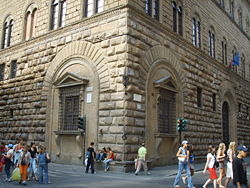- Palazzo Medici Riccardi
-
For other uses, see Palazzo Medici (disambiguation).
The Palazzo Medici, also called the Palazzo Medici Riccardi after the later family that acquired and expanded it, is a Renaissance palace located in Florence, Italy.
History
The palace was designed by Michelozzo di Bartolomeo[1] for Cosimo de' Medici, head of the Medici banking family, and was built between 1445[2] and 1460. It was well known for its stone masonry that includes rustication and ashlar.[3] The tripartite elevation used here expresses the Renaissance spirit of rationality, order, and classicism on human scale. This tripartite division is emphasized by horizontal stringcourses that divide the building into stories of decreasing height. The transition from the rusticated masonry of the ground floor to the more delicately refined stonework of the third floor makes the building seem lighter and taller as the eye moves upward to the massive cornice that caps and clearly defines the building's outline.
Michelozzo di Bartolomeo was influenced in his building of this palace by both classical Roman and Brunelleschian principles. During the Renaissance revival of classical culture, ancient Roman elements were often replicated in architecture, both built and imagined in paintings. In the Palazzo Medici Riccardi, the rusticated masonry and the cornice had precedents in Roman practice, yet in totality it looks distinctly Florentine, unlike any known Roman building.
Similarly, the early Renaissance architect Brunelleschi used Roman techniques and influenced Michelozzo. The open colonnaded court that is the center of the palazzo plan has roots in the cloisters that developed from Roman peristyles. The once open corner loggia and shop fronts facing the street were walled in during the 16th century. In their place, Michelozzo placed ground-floor "kneeling windows" (finestre inginocchiate) supported on innovative scrolling consoles and framed in pedimented aedicules that recall the similarly treated main doorway.
The "kneeling windows" a feature later copied by the Medici at their Palazzo Pitti, also in Florence.
The building reflects the accumulated wealth of the Medici family. The fifteen-year-old Galeazzo Maria Sforza was entertained in Florence in 17 April 1459, and left a letter describing, perhaps in the accomplished terms of a secretary, the all-but-complete palazzo, where his whole entourage was nobly[4] accommodated:
...a house that is — as much in the handsomeness of the ceilings, the height of the walls, smooth finish of the entrances and windows, number of chambers and salons, elegance of the studies, worth of the books, neatness and gracefulness of the gardens, as it is in the tapestry decorations,[5] cassoni of inestimable workmanship and value, noble sculptures, designs of infinite kinds, as well of priceless silver — the best I may ever have seen..."[6]
Niccolò de' Carissimi, one of Galeazzo Maria's counsellors, furnished further details of the rooms and garden:
decorated on every side with gold and fine marbles, with carvings and sculptures in relief, with pictures and inlays done in perspective by the most accomplished and perfect of masters even in the very benches and floors of the house; tapestries and household ornaments of gold and silk;silverware and bookcases that are endless... then a garden done in the finest of polished marbles, with diverse plants, which seems a thing not natural but painted."[7]
Cosimo received the young Sforza in the chapel "not less ornate and handsome than the rest of the house". The building still includes, as its only 15th century interior that is largely intact, the Magi Chapel, frescoed by Benozzo Gozzoli, who completed it in 1461 with a wealth of anecdotal detail of character types traditionally held to be portraits of members of the Medici family, along with the emperors John VIII Palaiologos and the Emperor Sigismund of Luxemburg, parading through Tuscany in the guise of the Three Wise Men.[8] Other decorations included two lunettes by Filippo Lippi, depicting Seven Saints and the Annunciation, now at the National Gallery, London.
When the Medici family returned to Florence after their short-lived exile in the early 15th century, they kept a low profile and executed their power behind the scenes. This is reflected in the plain exterior of this building, and is said to be the reason why Cosimo de' Medici rejected Brunelleschi's earlier proposal.
The palace was the site of the wedding reception between Ferdinando de' Medici, Grand Prince of Tuscany and Violante Beatrice of Bavaria in 1689.
Notes
- ^ Fabriczy, Michelozzo di Bartolommeo, 38, 41f.
- ^ Aby Warburg, "Die Baubeginn des Palazzo Medici", in Gesamelte Schriften, (Leipzig and Berlin) 1932: v. I, 165.
- ^ Vespasiano da Bisticci estimated that the structure alone had cost 60,000 ducats; the inventory of moveables in 1492 totalled just over 81,000. (Rab Hatfield, "Some Unknown Descriptions of the Medici Palace in 1459" The Art Bulletin 52.3 (September 1970:232-249), p. 235 and notes.
- ^ "...with such honor that where the least important of them is staying, the emperor could be accommodated," asserted Niccolò de' Carissimi in a letter quoted by Hatfield 1970:232.
- ^ Tapestries covered walls that were simply plastered, complementing the rich painted and gilded woodwork of ceilings.
- ^ Hatfield 1970:232.
- ^ Hatfield 1970:233.
- ^ Cristina Acidini discounts this long-held legend in her essay in The Chapel of the Magi. Benozzo Gozzoli's Frescoes in the Palazzo Medici Riccardi Florence (London: Thames & Hudson) 1994.
External links
Coordinates: 43°46′31″N 11°15′20″E / 43.775200°N 11.255429°E
Religious sites Battistero | Brancacci Chapel | Orsanmichele | San Lorenzo | San Marco | San Miniato | Santa Croce | Santa Maria del Fiore | Santa Maria Novella | Santo Spirito | Great SynagogueMuseums, galleries, and palaces Accademia | Bargello | David | Institute and Museum of the History of Science | Museo dell'Opera del Duomo | National Archaeological Museum | Palazzo Gondi | Palazzo Medici | Palazzo Pitti | Palazzo Strozzi | Palazzo Vecchio | UffiziNotable landmarks Giotto's Campanile | Ponte Vecchio | TheatresGardens and parks People Institutions Buildings Related Categories:- 1460 establishments
- 1460s architecture
- Palaces in Florence
- Renaissance architecture in Florence
- House of Medici
Wikimedia Foundation. 2010.



